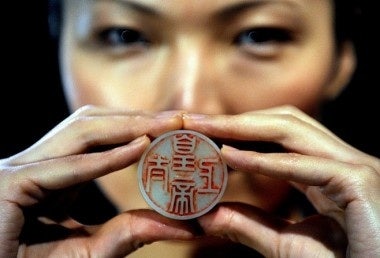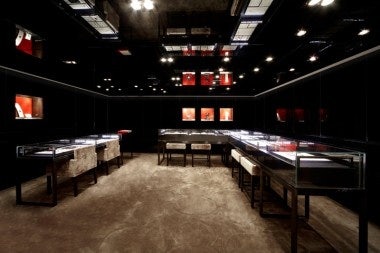Price For Finest Jade Has Risen Ten-Fold In Last Decade, Approaching $3,000 Per Ounce#

This week, the New York Times ran an article on the rapidly rising price of high-quality jade in China, noting that the finest "mutton fat" jade from the country's western Xinjiang province can now fetch around $3,000 per ounce. According to the article, China is in the midst of a "jade boom" fueled by the country's nouveau riche, whose new-found wealth and "5,000-year affinity" for the precious stone has caused prices for fine jade to rise ten-fold over the past decade. From the article:
“The love of jade is in our blood, and now that people have money, everyone wants a piece around their neck or in their home,” Zhang Xiankuo, a Chinese salesman, said as he opened a safe to show off his company’s most expensive carved items, among them a pair of kissing swans that retails for $150,000 and a contemporary rendition of a Tang dynasty beauty, her breasts impertinently exposed, that can be purchased for $80,000.
China's jade boom, which has gained most of its momentum over the past two years, hasn't flown entirely under the radar. At a number of recent auctions in Hong Kong and elsewhere, (primarily) Chinese buyers have sought out particularly covetable lots of jade and its rarer Burmese cousin jadeite, occasionally spending outrageous amounts. Earlier this year, a Chinese buyer purchased an imperial white jade seal that once belonged to the Qing emperor Qianlong (1711-1799) at auction for $12.3 million, and at Bonham's in London this May, a collection of 66 jade carvings sold for $3.6 million, double their pre-sale estimates.
So what explains China's skyrocketing jade prices? According to Tsinghua University economics professor (and Jing Daily "10 for '10" contributor) Patrick Chovanec, the jade boom isn't just a coincidence -- and can't be explained by jade's rarity (since it's not, by any means, rare) -- but rather fits with three important trends that are currently "shaping the Chinese economy": the rush to portable assets; concerns about inflation; and the country's vast "grey economy." From Chovanec's Seeking Alpha blog:
The rising price of jade — especially over the past year or so — might be merely an interesting curiosity, except that it fits with several of more important trends shaping the Chinese economy that I’ve been discussing in this blog:
1. The channeling of China’s savings into ”stores of value,” like gold or vacant real estate
, that are themselves unproductive but offer people a place to stash their cash given a limited choice of alternatives. I’ve noted many times the central role this factor plays in fueling China’s property market. I’ve also noted how, when the government stepped in with “cooling measures” to rein in real estate speculation, plenty of Chinese investors switched from property to gold, which served much the same need. The rising price of jade suggests, not surprisingly, that it is also playing a similar function.
2. Asset inflation, due to the large amounts of newly-created money sloshing around in the Chinese economy
. China’s money supply expanded by over 30% last year (year on year) and nearly 20% again this year, yet economists are scratching their heads why this has not shown up in consumer inflation (at least according to official staistics, which has August CPI at 3.5%). I’ve argued that the excess money has been going mainly into savings rather than consumption, bidding up prices in real estate, gold, and (now apparently) jade, hence the latest rise in jade prices.
3. The role of unreported “grey income” in China’s economy
. A recent report by Wang Xiaolu of the China Reform Foundation, published by Credit Suisse, has attracted a great deal of attention by claiming that wealthy Chinese have US$1.5 trillion in hidden income (accounting for over 30% of GDP), presumably derived from bribes, kickbacks, or tax evasion. Portable, non-traceable assets like gold and jade are an ideal form of storing such gains – far better than bank accounts, which can be traced and confiscated, or real estate, which to avoid scrutiny would have to be registered and held through relatives or other nominees. If Wang’s study is accurate, no wonder the market for jade is booming.
Chovanec's observations are both timely and can be applied to any type of portable asset, whether it's gold or jade jewelry or a rare Patek Philippe watch, a case of '82 Lafite, or artwork by blue-chip Chinese artists like Liu Ye, Zao Wou-Ki or Yue Minjun. As Jing Daily has pointed out regularly over the past year, many Chinese collectors at auction know little about wine or art, yet they're looking to stash their cash -- whether legitimately accrued or not -- into non-RMB-denominated assets that will sidestep Chinese inflation and be sold later to a buyer who'll be paying with a stronger yuan. This phenomenon goes far beyond jade.
To paraphrase Chovanec's conclusion, it's no wonder that the art, antique, jewelry, watch and wine markets are booming as well.

So who, aside from Xinjiang jade dealers or major auction houses, stands to benefit from the jade boom? In our opinion, some of the biggest beneficiaries -- given jade continues to catch on not only among those looking to "stash their cash" but also with China's younger, more fashionable generation -- may be home-grown jewelry brands like Qeelin or Zhaoyi, whose collections heavily feature the use of jade.
As Jing Daily wrote earlier this summer, unlike China's upstart luxury fashion or automotive brands -- which must compete directly with established brands from Europe, North America and Japan -- jade-heavy jewelry brands can actually benefit from their "made in China" status.
Much like Shang Xia, Hermes' new Chinese sub-brand, brands like Qeelin are actively marketing Chinese jade design and craftsmanship. If prices for jade, not just of the $3,000 per ounce variety, continue to rise, we could see the Zhaoyi or Qeelin realistically become something of a Chinese version of Tiffany or Cartier within a couple of decades.